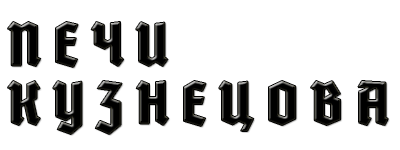620143 Ekaterinburg
Pobedy Street 51 - 87
What is the furnace Igor Kuznetsov, abbreviated.
What is the furnace Igor Kuznetsov, abbreviated?

For thousands of years “forced gas movement” was used in furnaces, refer to fig.2. In those types of furnaces, movement of gases is due to thrust through the chimney. The main characteristic of these furnaces is that gases at different temperatures are not separated while inside the firebox; there is a mixture of hot and ballast gases inside the firebox and convective system. Carriers of warmth, CO2 and H2O, are released via the chimney. In this case, the burning of fuel and preservation of warmth are less efficient. Furnaces using the “forced gas movement” system are characterized by the inferior capture and usage of energy.
.bmp) The “Free gas movement” furnace system by Igor Kuznetsov is shown in Fig.3. The firebox has a vertical slit, 2-3 cm wide, called “dry seam”. During the burning reaction in this type of furnace gases separate based on temperature levels. Carriers of warmth, CO2 and H2O, are not released via the chimney, in comparison to the “forced gas movement” system. They go up into the bell and release their heat there. Ballast gases are released through the “dry seam” without cooling down the bell.
The “Free gas movement” furnace system by Igor Kuznetsov is shown in Fig.3. The firebox has a vertical slit, 2-3 cm wide, called “dry seam”. During the burning reaction in this type of furnace gases separate based on temperature levels. Carriers of warmth, CO2 and H2O, are not released via the chimney, in comparison to the “forced gas movement” system. They go up into the bell and release their heat there. Ballast gases are released through the “dry seam” without cooling down the bell.
The cooled down CO2 and H2O descend down the sides of the cap, see Fig.A3. Fig.A3 shows the bell and the heating source at the bottom – C. During burning, the movement of the starting hydrocarbon materials (C+H2) takes place in the center of the .bmp) firebox. The movement of the cooled gases CO2 and H2O, as well as the ballast gases, descends down along the sides where the temperature is lower. Where these gases moving in opposite direction meet, turbulence occurs. In this case, as opposed to the “forced gas movement” system, all necessary conditions and materials are available to create a restorative and oxidative chemical reactions: mixing carbon (С) with oxygen (О2), water gas (Н2О), carbon dioxide (СО2). With the appearance of the following gases:
firebox. The movement of the cooled gases CO2 and H2O, as well as the ballast gases, descends down along the sides where the temperature is lower. Where these gases moving in opposite direction meet, turbulence occurs. In this case, as opposed to the “forced gas movement” system, all necessary conditions and materials are available to create a restorative and oxidative chemical reactions: mixing carbon (С) with oxygen (О2), water gas (Н2О), carbon dioxide (СО2). With the appearance of the following gases:
Air gas, С+О2=СО2; 2С+О2=2СО;
Water gas, С+Н2О=СО+Н2+2802 кcаl/nм3, С+2Н2О=СО2+2Н2+1714 кcal/nм3; This does not require energy to create water steam, since the water steam is the result of a fuel burning reaction, e.i. the reaction of water vapors burning is exothermic. When carbon interacts with carbon dioxide in the result of restorative reaction we receive carbon monoxide, burning gas as per well-known reaction С+СО2=2СО
In thermo chemical equations we must consider in what condition the matter is (liquid, solid state or gas). Therefore one and the same reaction can have different thermal effect depending on the matter state. In the above equation carbon is in solid state und requires preliminary heating, e.i. we have an endothermic reaction.
In our method of fuel combustion carbon of fuel, hydrocarbon and CO2do not require preliminary heating. That is we have the case of exothermic reaction. The carbon monoxide CO is burnt with heat release, СО+1/2О2=СО2+3018 кcal/nм3 СО. In the zones of moving flows flowing towards each other turbulent movement, diffusion takes place; therefore the mixture of matters will be homogeneous.
The processes of reduction and oxidation (combustion) pass continuously with the release of additional heat. The heat content of the fuel during its combustion in heat generators in Kuznetsov’s system of free gas movement exceeds its thermal capacity. This also explains that during stove testing as per direct balance the stove efficiency exceeds 100 %.
The furnace that was tested in Murzinka on 12.06.2018 conducted by the “Nuclear and renewable energy station” chair of the Ural Federal University named after the first President of Russia Boris Yeltsin, Mira Street 19, Ekaterinburg, Russia 620002. Email: s.e.shcheklein@urfu.ru. Tel.: +7(343)375-95-08 achieved the efficiency of 117,2% as per direct balance.
More here: The system of domestic furnaces, their features and differences, http://eng.stove.ru/stati/sistemyi_byitovyih_pechey_ih_priznaki_i_razlichiya
Igor Kuznetsov, 14.09. 2018 г

